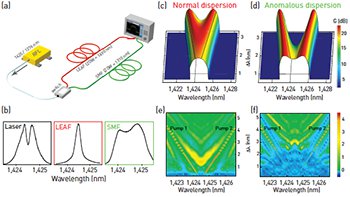 (a) Experimental design; RFL: Raman fiber laser. (b) Initial spectrum and spectrum after propagation in 100 km of LEAF and SMF-28 fibers. Power launched into each fiber = 1.5 W. (c-f) Signal gain spectra as a function of pump wavelength spacing. (c, d) Four-wave model: pump power = 1.5 W, L = 1 km. Black lines show the corresponding wavelengths of the pumps. (e, f) Nonlinear Schrödinger equation model: pump power = 1.5 W, signal power = 300 mW, L = 1 km. [Reprinted by permission from Macmillan Publishers Ltd: S.K. Turitsyn et al. Nat. Photon. 9, 608 (2015)]
(a) Experimental design; RFL: Raman fiber laser. (b) Initial spectrum and spectrum after propagation in 100 km of LEAF and SMF-28 fibers. Power launched into each fiber = 1.5 W. (c-f) Signal gain spectra as a function of pump wavelength spacing. (c, d) Four-wave model: pump power = 1.5 W, L = 1 km. Black lines show the corresponding wavelengths of the pumps. (e, f) Nonlinear Schrödinger equation model: pump power = 1.5 W, signal power = 300 mW, L = 1 km. [Reprinted by permission from Macmillan Publishers Ltd: S.K. Turitsyn et al. Nat. Photon. 9, 608 (2015)]
It is common knowledge in the fiber optics field that nonlinear effects such as four-wave mixing and self-phase modulation lead to spectral broadening when relatively high-power CW signals propagate in optical telecommunication fibers.1-3 We have introduced a new nonlinear self-action effect in optical fiber: inverse four-wave mixing or self-parametric amplification, which manifests itself as optical-spectrum narrowing in normal dispersion fiber, leading to very stable propagation with a distinctive spectral distribution.
The experimental set-up includes a CW pump source and standard transmission fibers with different zero-dispersion wavelengths. A Raman fiber laser, pumped by an ytterbium-doped fiber laser, generated a CW signal at 1,425 nm with an output power up to 2 W. The laser radiation at 1,425 nm was launched into 100 km of LEAF and SMF-28 fibers with a zero-dispersion wavelength around 1,500 nm for LEAF and 1,310 nm for SMF-28 fibers. When we compared outputs from LEAF and SMF-28 fibers, we found that the optical spectrum after LEAF with normal dispersion was significantly narrower than the input spectrum in contrast to the traditional spectral broadening after SMF-28 fiber (anomalous dispersion). Interestingly, spectral compression was observed in the same SMF-28 fiber when the laser wavelength was changed to 1,275 nm, where the SMF-28 dispersion is normal. The narrowing is a result of inverse four-wave mixing, which resembles an effective self-parametric amplification of the central part of the wave-packet spectrum by energy transfer from the peripheral wavelengths, playing the role of the pumps.4
This simplistic parametric amplification analogy clarifies all the key features observed in our experiments and full numerical modelling. It helps to explain why the effect is observed only in the normal dispersion regime. In this case, two-pump parametric gain is maximized in the center, providing a basis for effective redistribution of energy from spectral tails to the center. When the dispersion is anomalous, symmetric gain maxima are always located outside the area between the pumps, which effectively leads to significant spectrum broadening. The resulting state, featuring a narrow spectrum and random temporal field distribution, propagates with remarkable stability over the long span of a normal dispersion fiber, showing potential for applications in fiber lasers and optical communications.4,5
Researchers
Sergei K. Turitsyn, Aston University, Birmingham, U.K., and Novosibirsk State University, Novosibirsk, Russia
Anastasia E. Bednyakova and Mikhail P. Fedoruk, Novosibirsk State University and the Institute of Computational Technologies, Novosibirsk, Russia
Serguei B. Papernyi and Wallace R.L. Clements, MPB Communications Inc., Montréal, Québec, Canada
References and Resources
1. G. Agrawal. Nonlinear Fiber Optics, Academic Press (2007).
2. B. Barviau et al. Opt. Lett. 31, 1696 (2006).
3. S.A. Babin et al. Phys. Rev. A 77, 033803 (2008).
4. S.K. Turitsyn et al. Nat. Photon. 9, 608 (2015).
5. S. Radic. Nat. Photon. 9, 556 (2015).
